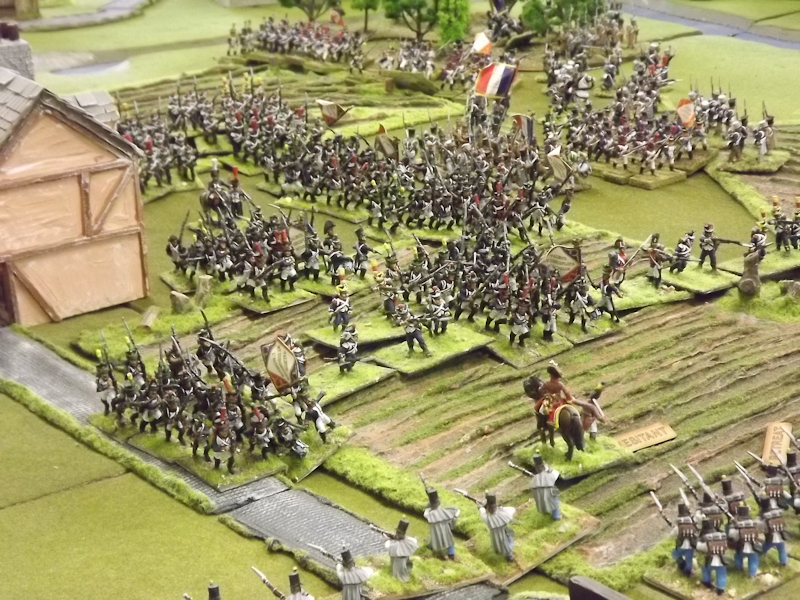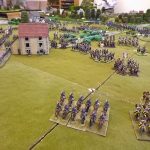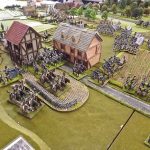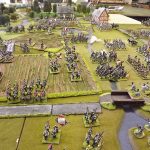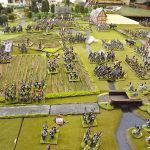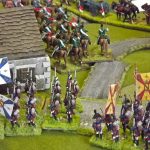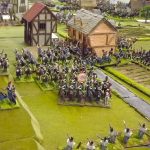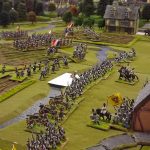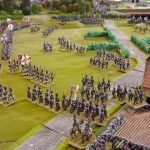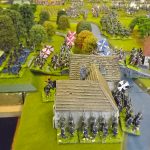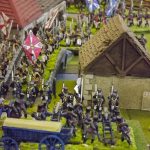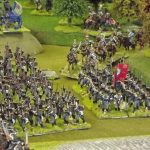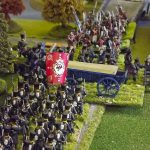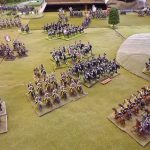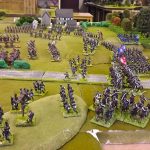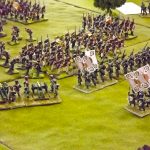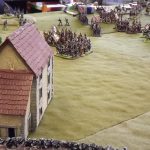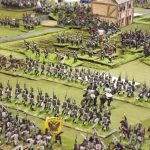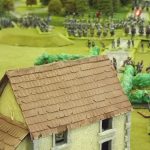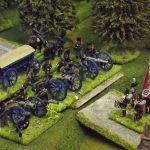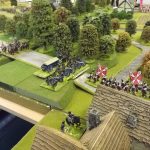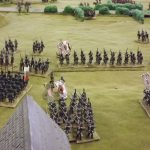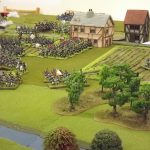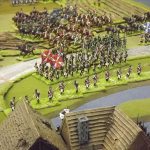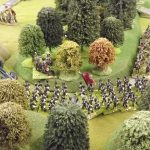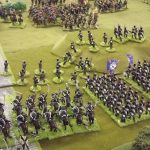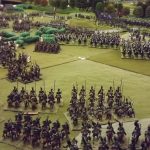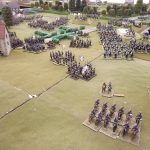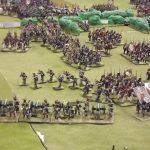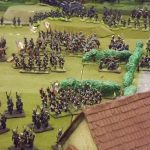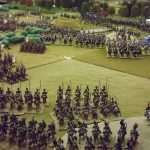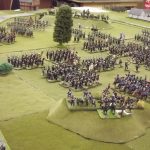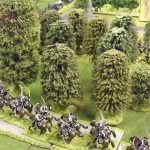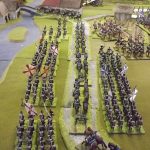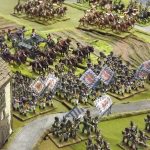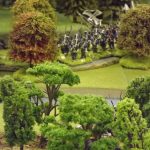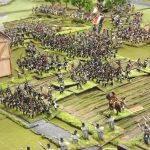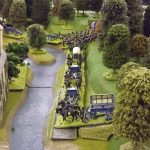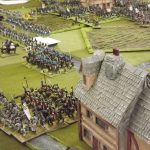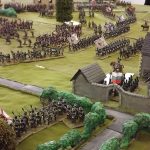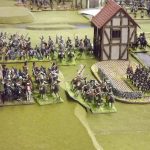Katzbach August 1813 Reimagined (with General d’Armee)
NB This is not a refight as such – no torrential rain, broken bridges and muddy ground! We are using the terrain and approximations of formation strengths etc., plus the strategic background to set the battle.
Bl Plan
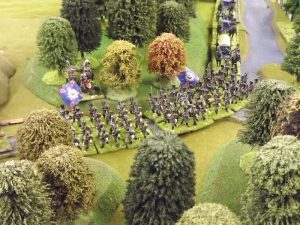 Graf von Blücher largely followed historical deployment with Sacken’s Russian Corps (17 battalions, 8 regiments and 5 batteries) and Yorck’s Prussian Corps (10 large battalions, 4 regiments and 2 batteries) deployed on his right to push through the plateau above the Neisse and (hopefully) drive the French back on the Katzbach. Meanwhile, Langeron’s Corps (18 large battalions, 10 regiments and 6 batteries) [commanding Austrians rather than Russians…] was to advance on the left to hold the French in place and defend the bridges over the Neisse.
Graf von Blücher largely followed historical deployment with Sacken’s Russian Corps (17 battalions, 8 regiments and 5 batteries) and Yorck’s Prussian Corps (10 large battalions, 4 regiments and 2 batteries) deployed on his right to push through the plateau above the Neisse and (hopefully) drive the French back on the Katzbach. Meanwhile, Langeron’s Corps (18 large battalions, 10 regiments and 6 batteries) [commanding Austrians rather than Russians…] was to advance on the left to hold the French in place and defend the bridges over the Neisse.
MacDonald’s Plan
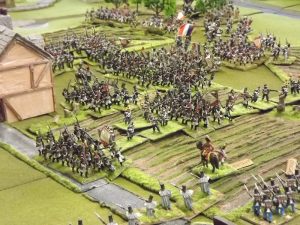 In a reverse of history, Maréchal MacDonald assigned Souham’s huge III Corps (33 battalions, 4 regiments and 6 batteries) to the right flank with orders to pin Blücher and secure the bridges over the Neisse at Nieder-Krayn and Schlaupe.
In a reverse of history, Maréchal MacDonald assigned Souham’s huge III Corps (33 battalions, 4 regiments and 6 batteries) to the right flank with orders to pin Blücher and secure the bridges over the Neisse at Nieder-Krayn and Schlaupe.
The turning movement on the left would be the responsibility of Lauriston’s and Gérard’s smaller V and XI Corps (14 battalions, 1 large regiment, 3 batteries and 9 battalions, 1 regiment, 3 batteries) respectively, coming over the Katzbach [using one of the bridges that historically fell foul of rising water levels] but supported – if it could negotiate the wooded ravines and escarpments along the Neisse – by Sébastiani’s II Cavalry Corps (12 regiments and 2 batteries) which, in a nod to actual events in 1813, had to use the bridge at Kroitsch, i.e. start on the “wrong” side of the Neisse.
c.9:00am
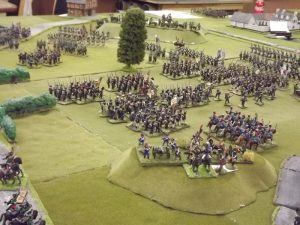 The French advanced Lauriston’s V Corps on the left, across the Katzbach at Döhna, with the corps’ artillery moving “Forwards!” to attempt to seize one of the few areas of commanding ground on the plateau. Similarly, the leading divisions of Souham’s III Corps advanced on the right, successfully occupying Nieder-Krayn and Ober-Krayn with légère and revealing [from Fog of War cards] Langeron’s Advance Guard which was picketing the line of the stream at Nieder-Krayn.
The French advanced Lauriston’s V Corps on the left, across the Katzbach at Döhna, with the corps’ artillery moving “Forwards!” to attempt to seize one of the few areas of commanding ground on the plateau. Similarly, the leading divisions of Souham’s III Corps advanced on the right, successfully occupying Nieder-Krayn and Ober-Krayn with légère and revealing [from Fog of War cards] Langeron’s Advance Guard which was picketing the line of the stream at Nieder-Krayn.
MacDonald [rated “Veteran” and so gaining two extra ADCs] expanded considerable energy [i.e. ADCs] ensuring that Sébastiani’s II Cavalry Corps began moving along the military road, over the Katzbach at Kroitsch and towards the Nieder-Krayn bridge. Gérard’s XI Corps behind the Katzbach was as yet uncommitted.
Blücher [rated “Tactician” with three extra ADCs] meanwhile was hurrying Sacken’s Corps’ Russian cavalry “Forwards!” on his extreme right as well as bringing up the leading Russian and Prussian infantry divisions. On the left Langeron’s Corps’ Austrians [see above!] were filing through Hermannsdorf whilst some distance ahead of them their Advance Guard shuffled backwards a little to try to bring its cavalry out of view of Souham’s III Corps’ artillery whilst still in a position to discomfort any French columns that might be disordered crossing the Krayn stream.
c.11:00am
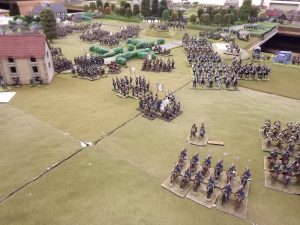 On the French left, Maison’s 16th Division of Lauriston’s V Corps reached Jänowitz but was forced into square by the advancing Russian cavalry of Sacken’s Corps under Generals Karpov and Tschaplitz. An attempt to break one of the squares with Cossacks predictably failed but a series of charges by Cossacks and Hussars forced back the weak French V Corps’ cavalry brigade under GdB Dermancourt. Russian horse artillery unlimbered to take the squares under fire but were discomforted by excellent skirmishing fire from Maison’s light troops in Jänowitz. To Maison’s right the 19th Division under GdD Rochambeau pushed into the centre of the broad plateau heading for “Blücher’s Lime Tree” but were confronted by a line of skirmishing Russian Jägers whilst behind them Russian guns began to mass ominously on the Taubenberg, one of the few high points on the plateau. With both Sacken’s Corps and Yorck’s Corps debouching onto to plateau opposite him Lauriston’s Corps is advancing against twice his numbers in foot and guns…
On the French left, Maison’s 16th Division of Lauriston’s V Corps reached Jänowitz but was forced into square by the advancing Russian cavalry of Sacken’s Corps under Generals Karpov and Tschaplitz. An attempt to break one of the squares with Cossacks predictably failed but a series of charges by Cossacks and Hussars forced back the weak French V Corps’ cavalry brigade under GdB Dermancourt. Russian horse artillery unlimbered to take the squares under fire but were discomforted by excellent skirmishing fire from Maison’s light troops in Jänowitz. To Maison’s right the 19th Division under GdD Rochambeau pushed into the centre of the broad plateau heading for “Blücher’s Lime Tree” but were confronted by a line of skirmishing Russian Jägers whilst behind them Russian guns began to mass ominously on the Taubenberg, one of the few high points on the plateau. With both Sacken’s Corps and Yorck’s Corps debouching onto to plateau opposite him Lauriston’s Corps is advancing against twice his numbers in foot and guns…
Sébastiani’s II Cavalry Corps laboriously navigated its way along the military road via the bridges at Kroitsch and Nieder-Krayn and up the escarpment on the northern bank of the Neisse to emerge on the plateau with the 2nd Light Cavalry Division and the 2nd Heavy Cavalry Division. Unfortunately, they are still a long way from the left flank of V Corps which is threatened with being overrun by the two Russian Cavalry Divisions. Meanwhile, the 4th Light Cavalry Division, led by the incomparable GdD Exelmans and bringing up the rear of II Cavalry Corps, has encountered Prussian Hussars from Yorck’s Corps advancing from the bridge at Schlaupe, both sides strong out in march column along the wooded roads.
Gérard’s XI Corps, which might have been sensibly deployed to cover Lauriston’s V Corps’ left and rear was belated committed from reserve by Maréchal MacDonald, but dithering over his orders by GdD Gérard meant that it remains on the far bank on the Katzbach [MacDonald found the necessary two ADCs to commit a reserve division only to have Gérard’s lead division go “Hesitant”].
 On the French right, Souham’s III Corps’ two lead divisions – GdD Delmas’ 9th Division on the left and GdD Brayer’s 8th Division on the right, a total of 5 légère and 11 ligne battalions – advanced to throw the Austrian Advance Guard under General Tallisin – gamely tasked by Langeron with the job of slowing the French attack whilst he deployed the rest of his Corps’ from distant Hermannsdorf – back from the Krayn stream and out of the village of Seichau. The French advance was unsophisticated: both divisions quickly went over to the attack [“Infantry Assault”] and after securing Nieder- and Ober-Krayn with light infantry headed across the stream with a strong cloud of skirmishers to the front. Brayer’s 8th Division were slowed by a brief period of command confusion [“Hesitant”] and the stream discomforted both [for the minor streams we allowed crossing by infantry and cavalry at full speed Unformed or half speed Formed] which gave the Austrian Advance Guard’s lone Grenzer light battery time to get off some telling shots [double 6 with its very first bombardment!] at the massed columns of Frenchmen before it withdrew. The Austrian Jäger deployed in Krayn Wald were heavily out-skirmished by the mass of French light troops and after taking significant losses Langeron opted to use what remained of the battalion to reinforce his depleted Brigade Skirmish Line rather than risk the early dispersal of both units. The French infantry attack forced the Advance Guard to fall back whilst keeping a Grenzer battalion in Sechau, though it has largely done its job as the rest of Langeron’s Corps has shaken out into long lines along the Silber stream near Hennersdorf [the Austrians were greatly helped by the “Forwards!” option costing only one additional ADC when a command is more than 30” from the enemy]. Indeed their Cavalry Division under General Korf is now positioned menacingly on GdD Delmas’ left flank and may force the French infantry into square thereby ending forward movement in that sector. The III Corps’ advance has necessarily been along a narrow front and the lack of high ground has severely hampered the use of its artillery – “Napoleon’s Daughters” have yet to fire a shot! – merely discouraging by their presence Austrian cavalry from coming too near on the French right flank.
On the French right, Souham’s III Corps’ two lead divisions – GdD Delmas’ 9th Division on the left and GdD Brayer’s 8th Division on the right, a total of 5 légère and 11 ligne battalions – advanced to throw the Austrian Advance Guard under General Tallisin – gamely tasked by Langeron with the job of slowing the French attack whilst he deployed the rest of his Corps’ from distant Hermannsdorf – back from the Krayn stream and out of the village of Seichau. The French advance was unsophisticated: both divisions quickly went over to the attack [“Infantry Assault”] and after securing Nieder- and Ober-Krayn with light infantry headed across the stream with a strong cloud of skirmishers to the front. Brayer’s 8th Division were slowed by a brief period of command confusion [“Hesitant”] and the stream discomforted both [for the minor streams we allowed crossing by infantry and cavalry at full speed Unformed or half speed Formed] which gave the Austrian Advance Guard’s lone Grenzer light battery time to get off some telling shots [double 6 with its very first bombardment!] at the massed columns of Frenchmen before it withdrew. The Austrian Jäger deployed in Krayn Wald were heavily out-skirmished by the mass of French light troops and after taking significant losses Langeron opted to use what remained of the battalion to reinforce his depleted Brigade Skirmish Line rather than risk the early dispersal of both units. The French infantry attack forced the Advance Guard to fall back whilst keeping a Grenzer battalion in Sechau, though it has largely done its job as the rest of Langeron’s Corps has shaken out into long lines along the Silber stream near Hennersdorf [the Austrians were greatly helped by the “Forwards!” option costing only one additional ADC when a command is more than 30” from the enemy]. Indeed their Cavalry Division under General Korf is now positioned menacingly on GdD Delmas’ left flank and may force the French infantry into square thereby ending forward movement in that sector. The III Corps’ advance has necessarily been along a narrow front and the lack of high ground has severely hampered the use of its artillery – “Napoleon’s Daughters” have yet to fire a shot! – merely discouraging by their presence Austrian cavalry from coming too near on the French right flank.
c.12:30pm
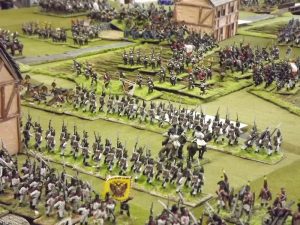 On the Russia right, General Karpov’s Russian cavalry division were having a field day: they routed Dermancourt’s brave Chasseurs à Cheval and then over-ran [“Charge On!”] the 12pdr gun battery from Lauriston’s V Corps! A second French battery was swept away despite some desperate canister fire [5 casualties inflicted on the attacking Russian cavalry regiment but the Discipline Test was duly passed with the lowest possible score – 11]. Suddenly the entire rear of the French left flank was exposed! Gérard’s XI Corps which were supposed to be filling the gap as Lauriston advanced remained stationary; MacDonald succeeded in committing two divisions to the battle but they resolutely refused to advance across the Katzbach [twice the divisions went “Hesitant” in the turn they were “committed from Reserve”]. Meanwhile, pressure on Maison’s 16th Division continued to grow as Russian artillery and Jägers massed to their front whilst Karpov and Tschaplitz’s presence obliged half the battalions to remain in square. Eventually the pressure proved too much and the division recoiled [forced to “Retire” when it went “Hesitant” as a Faltering command]. Only in the nick-of-time did St Germain’s 2nd Heavy Cavalry Division finally navigate its way through the detritus and impedimenta at the rear of Lauriston’s V Corps and arrive to challenge the rampaging Russian cavalry. A sacrificial opportunity charge by a Cossack regiment against the élite Carabiniers bought the Russians a little time but they face a stiff challenge from the massed French heavy cavalry.
On the Russia right, General Karpov’s Russian cavalry division were having a field day: they routed Dermancourt’s brave Chasseurs à Cheval and then over-ran [“Charge On!”] the 12pdr gun battery from Lauriston’s V Corps! A second French battery was swept away despite some desperate canister fire [5 casualties inflicted on the attacking Russian cavalry regiment but the Discipline Test was duly passed with the lowest possible score – 11]. Suddenly the entire rear of the French left flank was exposed! Gérard’s XI Corps which were supposed to be filling the gap as Lauriston advanced remained stationary; MacDonald succeeded in committing two divisions to the battle but they resolutely refused to advance across the Katzbach [twice the divisions went “Hesitant” in the turn they were “committed from Reserve”]. Meanwhile, pressure on Maison’s 16th Division continued to grow as Russian artillery and Jägers massed to their front whilst Karpov and Tschaplitz’s presence obliged half the battalions to remain in square. Eventually the pressure proved too much and the division recoiled [forced to “Retire” when it went “Hesitant” as a Faltering command]. Only in the nick-of-time did St Germain’s 2nd Heavy Cavalry Division finally navigate its way through the detritus and impedimenta at the rear of Lauriston’s V Corps and arrive to challenge the rampaging Russian cavalry. A sacrificial opportunity charge by a Cossack regiment against the élite Carabiniers bought the Russians a little time but they face a stiff challenge from the massed French heavy cavalry.
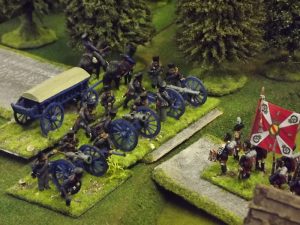 The rest of Sébastiani’s II Cavalry Corps – the 2nd Light Cavalry Division and the 4th Light Cavalry Division – were facing a nightmare of command-and-control in the confined space of the escarpment along the northern bank of the Neisse. The 2nd Light Cavalry had successfully made its way through the wooded defiles on to the plateau only to find their path blocked by Rochambeau’s 18th Infantry Division advancing across their path, whilst behind them Prussian Fusilier battalions were skirmishing in the woods and bring the stationary cavalry under a galling fire which they could do nothing about. Finally, half the division chanced its arm on feeding through a gap on Rochambeau’s right flank, only to fail to over-run an exposed Russian gun battery in a flank charge (the fifth or sixth time the Russians rolled 11 or 12 in a Charge Test that morning…). The 4th Light Cavalry Division fared even worse; stuck on the roads leading up from the Nieder-Krayn bridge they encountered Yorck’s Prussian Hussars under General Jürgass also in march column on the narrow valley road: round one went to the Lanciers du Ligne; round two to the Prussians, sending Exelman’s command reeling back across the Neisse and allowing Yorck’s Prussian foot to continue their remorseless advance right between the two wings of the French Army. MacDonald had clearly lost control of the battle, hampered by the terrain and some shocking lapses in command [French die rolling on the left flank was almost epically poor: 2 or 3 rolled in Charge or Discipline Test after Charge or Discipline Test].
The rest of Sébastiani’s II Cavalry Corps – the 2nd Light Cavalry Division and the 4th Light Cavalry Division – were facing a nightmare of command-and-control in the confined space of the escarpment along the northern bank of the Neisse. The 2nd Light Cavalry had successfully made its way through the wooded defiles on to the plateau only to find their path blocked by Rochambeau’s 18th Infantry Division advancing across their path, whilst behind them Prussian Fusilier battalions were skirmishing in the woods and bring the stationary cavalry under a galling fire which they could do nothing about. Finally, half the division chanced its arm on feeding through a gap on Rochambeau’s right flank, only to fail to over-run an exposed Russian gun battery in a flank charge (the fifth or sixth time the Russians rolled 11 or 12 in a Charge Test that morning…). The 4th Light Cavalry Division fared even worse; stuck on the roads leading up from the Nieder-Krayn bridge they encountered Yorck’s Prussian Hussars under General Jürgass also in march column on the narrow valley road: round one went to the Lanciers du Ligne; round two to the Prussians, sending Exelman’s command reeling back across the Neisse and allowing Yorck’s Prussian foot to continue their remorseless advance right between the two wings of the French Army. MacDonald had clearly lost control of the battle, hampered by the terrain and some shocking lapses in command [French die rolling on the left flank was almost epically poor: 2 or 3 rolled in Charge or Discipline Test after Charge or Discipline Test].
On the French right flank the immense III Corps under Souham continued to roll forward. Seichau was successfully stormed and Langeron’s Corps’ Advance Guard pushed back, dangerously close to total collapse [as previously mentioned the Jägers were absorbed into the Brigade Skirmish Line to avoid losing both units; additionally the Grenzer light battery was dispersed and the two Grenzer battalions are close to dispersal as well, with the Chevaulegers and Hussars being damaged]. However, on the plus side two French battalions have been brought to the verge of disintegration and half-a-dozen more battalions from 8th and 9th Divisions are heavily battered whilst the main Austrian line – the divisions of Rudsevitch and Hünnerbein have not been touched – but is entrenching along the Silber stream. Langeron can see there are still masses of French to his front but on a narrow frontage he is confident his large Austrian battalion lines will be able to hold…
c.1:30pm
On the French left, Lauriston’s V Corps remains in desperate straits. They had advanced into a cauldron of fire: Sachen’s Russian artillery and Jägers to the front, Russian Cossacks, Hussars, Uhlans and Dragoons on their left and now Prussian skirmishers appearing in the woods to their right, heralding the appearance of Yorck’s Corps. Sébastiani’s II Cavalry Corps was similarly desperately caught between two fires: the 2nd Heavy Cavalry Division was needed to stabilise the far left-rear whilst the 2nd Light Cavalry Division was virtually powerless to stop the advancing Prussians emerging from the woods. They attempt a number of charges but they were piecemeal affairs and the Prussian Hussars easily see them off, giving space for Prussian foot and guns to debouch from the very same road earlier used by GdD Roussel d’Hurbal own command [starved of supports the individual French cavalry regiments were at the mercy of their on-going poor dice rolling…]. Gérard’s XI Corps has finally bestirred itself led by valiant Poles under GdD Charpentier but they were completely detached from the forces they were meant to be supported and Lauriston’s command might be destroyed by the time they catch up…
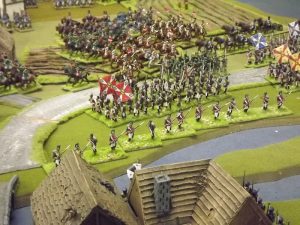 On the French right Souham’s III Corps has effectively seen off what remained of Langeron’s Corps’ Advance Guard but now faces the laborious and bloody task of shifting two Austrian divisions – 12 large battalion and two batteries – from along the line of the Silber. The narrow front means the Austrians will be deployed in no fewer than three lines of infantry and have had the luxury of withdrawing Korf’s Cavalry Division [via “Redeploy”] from their exposed position in the front line into reserve. Meanwhile the lead French Divisions – Brayer’s 8th and Delmas’ 9th – by no means fresh will have to either keep pressing with depleted battalions or somehow make way for the Bavarians in Albert’s 10th and Ricard’s 11th Divisions following them. If Souhan can bring up these divisions his artillery advantage will be potentially decisive but it is doubtful if he has the time – or space – for such “battlefield ballet”. Meanwhile, Souham’s division of Badeners – Marchard’s 39th – looks as if it will be needed to divert north to re-take Nieder-Krayn and its vital bridge from Yorck’s bloodthirsty Prussians. Since the Neisse is in full spate it will require a bridge assault… Not as perilous as at Lodi in 1796 but there are precious few veterans of that action left, or perhaps as long as at Landshut in 1809 but where is Mouton when needed?
On the French right Souham’s III Corps has effectively seen off what remained of Langeron’s Corps’ Advance Guard but now faces the laborious and bloody task of shifting two Austrian divisions – 12 large battalion and two batteries – from along the line of the Silber. The narrow front means the Austrians will be deployed in no fewer than three lines of infantry and have had the luxury of withdrawing Korf’s Cavalry Division [via “Redeploy”] from their exposed position in the front line into reserve. Meanwhile the lead French Divisions – Brayer’s 8th and Delmas’ 9th – by no means fresh will have to either keep pressing with depleted battalions or somehow make way for the Bavarians in Albert’s 10th and Ricard’s 11th Divisions following them. If Souhan can bring up these divisions his artillery advantage will be potentially decisive but it is doubtful if he has the time – or space – for such “battlefield ballet”. Meanwhile, Souham’s division of Badeners – Marchard’s 39th – looks as if it will be needed to divert north to re-take Nieder-Krayn and its vital bridge from Yorck’s bloodthirsty Prussians. Since the Neisse is in full spate it will require a bridge assault… Not as perilous as at Lodi in 1796 but there are precious few veterans of that action left, or perhaps as long as at Landshut in 1809 but where is Mouton when needed?
c.2:30pm
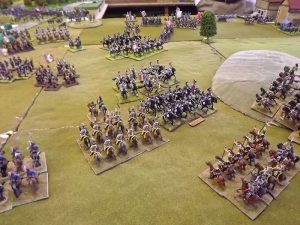 The intervention of Roussel d’Hurbal’s 2nd Heavy Cavalry Division looked to have stabilized affairs on MacDonald’s far right. A decisive cavalry charge (the French cuirassiers scoring 7/7 casualties and “Retiring to Own Lines” so, importantly, remaining Formed!) pinned Tschaplitz’s Russian Cavalry Division back and many of his and Karpov’s regiments are dangerously close to breaking. However, a second Cuirassier charge while victorious leaves the French troopers exposed to a counter-attack [“Unformed”] from the still superior numbers – at least in terms of regiments – of Russians under Sacken’s overall direction.
The intervention of Roussel d’Hurbal’s 2nd Heavy Cavalry Division looked to have stabilized affairs on MacDonald’s far right. A decisive cavalry charge (the French cuirassiers scoring 7/7 casualties and “Retiring to Own Lines” so, importantly, remaining Formed!) pinned Tschaplitz’s Russian Cavalry Division back and many of his and Karpov’s regiments are dangerously close to breaking. However, a second Cuirassier charge while victorious leaves the French troopers exposed to a counter-attack [“Unformed”] from the still superior numbers – at least in terms of regiments – of Russians under Sacken’s overall direction.
Less happily for Sébastiani’s II Cavalry Corps was the demoralisation of the 2nd Light Cavalry Division. Poor combat results against Prussian Hussars and Russian artillery plus incessant shooting from skirmishers nestling in the woods at the top of the escapement are proving their downfall and with the Prussians advancing on to the plateau there is less and less space for the French to occupy.
Indeed, Lauriston’s V Corps is beginning to look very fragile: Rochambeau’s Division too is demoralized by mounting losses. Gérard’s XI Corps is finally advancing and may give Yorck’s Prussians something to think about but it seems only a matter of time before Lauriston’s entire command gives way.
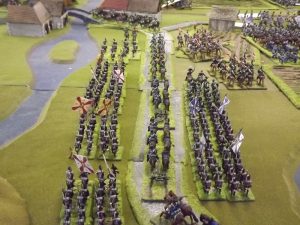 On the right flank Souham’s III Corps is also struggling. Some excellent shooting by the horse artillery attached to Beurmann’s Cavalry Division forced an Austrian battalion out of line but the opportunity to exploit the gap was lost as Brayer’s 8th Division chose that moment to temporarily lose its nerve [as a “Faltering” command due to the loss of a lead unit it failed its Command test – despite an ADC attachment – and rolled “Retire”]. Langeron has almost completed the ordering of his multiple lines of Austrian infantry and is looking confident. The 9th Division under Delmas is heading northeast for Schlauphof and its ford over the Neisse but a gap is opening behind as the 10th and 11th Divisions seem to take turns in failing to advance [one or both are often “Hesitant” and Souham cannot spare the ADCs to give them a re-roll]. The Badeners of Marchand’s 39th Division – originally intended as Souham’s “coup de grace” formation but now diverted to Nieder-Krayn to regain control of the bridge from Yorck’s Prussians – failed in their first assault. This leaves its column stuck on the bridge facing one Prussian Musketeer battalion in garrison to its immediate left flank and another in line to the front supported by a Prussian gun battery [under the scenario it should not have been able to deploy on the wooded escarpment but the Umpire failed to notice until too late; perhaps some of the trees rearranged themselves!]. There is support available from a Baden Foot Battery and skirmishers but it looks as is a battle of attrition will take too long from MacDonald’s point of view.
On the right flank Souham’s III Corps is also struggling. Some excellent shooting by the horse artillery attached to Beurmann’s Cavalry Division forced an Austrian battalion out of line but the opportunity to exploit the gap was lost as Brayer’s 8th Division chose that moment to temporarily lose its nerve [as a “Faltering” command due to the loss of a lead unit it failed its Command test – despite an ADC attachment – and rolled “Retire”]. Langeron has almost completed the ordering of his multiple lines of Austrian infantry and is looking confident. The 9th Division under Delmas is heading northeast for Schlauphof and its ford over the Neisse but a gap is opening behind as the 10th and 11th Divisions seem to take turns in failing to advance [one or both are often “Hesitant” and Souham cannot spare the ADCs to give them a re-roll]. The Badeners of Marchand’s 39th Division – originally intended as Souham’s “coup de grace” formation but now diverted to Nieder-Krayn to regain control of the bridge from Yorck’s Prussians – failed in their first assault. This leaves its column stuck on the bridge facing one Prussian Musketeer battalion in garrison to its immediate left flank and another in line to the front supported by a Prussian gun battery [under the scenario it should not have been able to deploy on the wooded escarpment but the Umpire failed to notice until too late; perhaps some of the trees rearranged themselves!]. There is support available from a Baden Foot Battery and skirmishers but it looks as is a battle of attrition will take too long from MacDonald’s point of view.
c.4.00pm
Around 4pm Lauriston’s V Corpshad had enough; Maison’s 16thDivision was demoralised whilst Rochambeau’s 18thhad quit the field entirely [“Sauve qui peut” on the Faltering Brigade table…]. Gérard’s XI Corpswas obviously discomforted by the stream of fleeing troops because it still had only half its units across the Katzbach and whilst they were undamaged and in good order they had little enthusiasm to close with superior numbers of Russian and Prussian troops under Sackenand Yorck. The Cuirassiers of the 2ndHeavy Cavalry Division had thoroughly wrecked both Karpov’s and Tschaplitz’s Russian Cavalry Divisions but the latter had the satisfaction that they had disrupted Maison’s advance, over-run two French batteries and prevented the enemy heavy cavalry from influencing the main infantry battle in any way. The French 2ndLight Cavalry Division had, by contrasted, disintegrated without making much of a contribution.
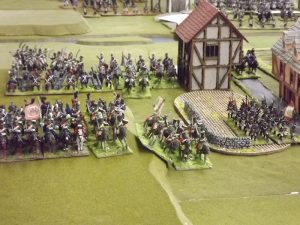 Souham’s III Corpswas slowly grinding its way forward of the right flank. Brayer’s 8thDivision cleared the Silber stream of defending Austrian infantry and reduced a gun battery to mere shreds but it was likely to be their last contribution having lost three battalions of their own and having three more in a truly parlous state. Delmas’ 9thDivision were similarly weak and unlikely to be able to capture Schauphof which Langeronhad speedily occupied once the French advance had been identified. The Bavarian 10thand 11thDivisions were available to be committed and might be able to push through Hennesberg but with Marchand’s 39thDivision diverted to Nieder-Krayn there would be no final break-through in the last 4-5 hours of daylight. Indeed, Marchand had sacrificed two-and-a-half battalions of good Baden troops to re-take the bridge at Nieder-Krayn but there was little more he could do as Yorckhad plenty of Prussian infantry to block the narrows leading up to the plateau. Finally made aware by MacDonald of the collapse on the French left, Souhamreluctantly ordered a retreat before it got dark.
Souham’s III Corpswas slowly grinding its way forward of the right flank. Brayer’s 8thDivision cleared the Silber stream of defending Austrian infantry and reduced a gun battery to mere shreds but it was likely to be their last contribution having lost three battalions of their own and having three more in a truly parlous state. Delmas’ 9thDivision were similarly weak and unlikely to be able to capture Schauphof which Langeronhad speedily occupied once the French advance had been identified. The Bavarian 10thand 11thDivisions were available to be committed and might be able to push through Hennesberg but with Marchand’s 39thDivision diverted to Nieder-Krayn there would be no final break-through in the last 4-5 hours of daylight. Indeed, Marchand had sacrificed two-and-a-half battalions of good Baden troops to re-take the bridge at Nieder-Krayn but there was little more he could do as Yorckhad plenty of Prussian infantry to block the narrows leading up to the plateau. Finally made aware by MacDonald of the collapse on the French left, Souhamreluctantly ordered a retreat before it got dark.
Gallery
